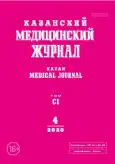Микогенная контаминация жилых помещений как фактор биологического риска
- Авторы: Халдеева Е.В.1, Глушко Н.И.1, Лисовская С.А.1,2, Паршаков В.Р.1, Хайдарова Г.Г.1
-
Учреждения:
- Казанский научно-исследовательский институт эпидемиологии и микробиологии Роспотребнадзора
- Казанский государственный медицинский университет
- Выпуск: Том 101, № 4 (2020)
- Страницы: 513-518
- Тип: Теоретическая и клиническая медицина
- URL: https://journal-vniispk.ru/kazanmedj/article/view/30773
- DOI: https://doi.org/10.17816/KMJ2020-513
- ID: 30773
Цитировать
Аннотация
Цель. Оценка уровня микогенной контаминации и видового состава грибковой микробиоты жилых помещений г. Казани.
Методы. Проведено микологическое исследование 90 проб воздуха, а также 60 образцов из очагов грибкового биоповреждения, отобранных в жилых помещениях г. Казани, с использованием культуральных и микроскопических методов.
Результаты. Присутствие грибов-микромицетов выявлено в 90% проб воздуха и 100% проб из очагов биоповреждения. Отмечено большее видовое разнообразие грибов в очагах по сравнению с пробами воздуха. Количество грибов в воздухе жилых помещений варьировало от 8 до 360 КОЕ/м3. Анализ видового состава грибковой микробиоты в очагах биоповреждения показал, что на поверхности очагов биоповреждения чаще присутствует контаминация неприхотливыми и способными к росту при различном уровне влажности видами грибов (Penicillium spp., Aspergillus spp., Rhizopus stolonifer). Возникающий грибковый налёт может создавать благоприятные условия для обитания более агрессивных грибов, активно повреждающих материалы (Chaetomium spp., Acremonium spp., Aureubasidium spp.). Отмечена широкая распространённость в воздухе жилых помещений аллергенных грибов, а также потенциально патогенных и токсинообразующих видов, что может быть фактором риска для здоровья людей. Количественная оценка микобиоты воздуха позволила охарактеризовать уровень выявленной микогенной контаминации как умеренный.
Вывод. Подтверждено присутствие в очагах биоповреждения потенциально патогенных, аллергенных и обладающих выраженными биоразрушающими свойствами видов грибов, а также взаимосвязь микогенной контаминации воздуха и распространения грибов в помещениях, что подтверждает необходимость предупреждения грибкового биоповреждения и контроля качества воздуха в помещениях.
Ключевые слова
Полный текст
Открыть статью на сайте журналаОб авторах
Елена Владимировна Халдеева
Казанский научно-исследовательский институт эпидемиологии и микробиологии Роспотребнадзора
Автор, ответственный за переписку.
Email: mycology-kazan@yandex.ru
Россия, г. Казань, Россия
Надежда Ивановна Глушко
Казанский научно-исследовательский институт эпидемиологии и микробиологии Роспотребнадзора
Email: mycology-kazan@yandex.ru
Россия, г. Казань, Россия
Светлана Анатольевна Лисовская
Казанский научно-исследовательский институт эпидемиологии и микробиологии Роспотребнадзора; Казанский государственный медицинский университет
Email: mycology-kazan@yandex.ru
Россия, г. Казань, Россия; г. Казань, Россия
Вениамин Романович Паршаков
Казанский научно-исследовательский институт эпидемиологии и микробиологии Роспотребнадзора
Email: mycology-kazan@yandex.ru
Россия, г. Казань, Россия
Гульназ Гумяровна Хайдарова
Казанский научно-исследовательский институт эпидемиологии и микробиологии Роспотребнадзора
Email: mycology-kazan@yandex.ru
Россия, г. Казань, Россия
Список литературы
- Рекомендации ВОЗ по качеству воздуха в помещениях: сырость и плесень. Копенгаген. 2009 (пер. рус. 2014). https://www.euro.who.int/ru/health-topics/environment-and-health/air-quality/publications/2009/who-guidelines-for-indoor-air-quality-dampness-and-mould.-executive-summary/who-guidelines-for-indoor-air-quality-dampness-and-mould (дата обращения: 06.05.2020).
- Марфенина О.Е., Фомичёва Г.М. Потенциальные патогенные мицелиальные грибы в среде обитания человека. Современные тенденции. В кн.: Успехи медицинской микологии. Т. 1. М.: Национальная академия микологии. 2007; 235–266.
- Васильева Н.В., Елинов Н.П. Микроорганизмы-контаминанты и патогены-индукторы процессов старения больничных зданий и помещений медицинского назначения, а также возбудители некоторых заболеваний людей. СПб.: Коста. 2009; 224 с.
- Старцев С.А., Антонов В.Б., Беляков Н.А. и др. Биоповреждения больничных зданий и их влияние на здоровье человека. Под ред. А.П. Щербо, В.Б. Антонова. СПб.: МАПО. 2008; 232 с.
- Богомолова Е.В., Уханова О.П., Санеева И.В. Микологические факторы риска в городской среде. Известия Самарского научного центра РАН. 2016; 18 (2–3): 637–641.
- Lottrup G., Andersson A.‐M., Leffers H. et al. Possible impact of phthalates on infant reproductive health. Int. J. Andrology. 2006; 29 (1): 172–180. doi: 10.1111/j.1365-2605.2005.00642.x.
- Kuhn D.M., Ghannoum M.A. Indoor mold, toxigenic fungi, and Stachybotrys chartarum: Infectious disease perspective. Clin. Microbiol. Rev. 2003; 16 (1): 144–172. doi: 10.1128/CMR.16.1.144-172.2003.
- Boutin-Forzano S., Kadouch-Charpin C., Hammou Y. et al. Indoor molds, mycotoxins and health. Environnement, Risques et Sante. 2006; 5: 383–389.
- Антонов В.Б. Антропогенно-очаговые болезни жителей большого города. Ж. инфектологии. 2009; 1 (2–3): 7–12.
- Губернский Ю.Д., Беляева Н.Н., Калинина Н.В. и др. К вопросу распространения и гигиенического нормирования грибкового загрязнения воздушной среды жилых и общественных зданий. Гигиена и санитария. 2013; (5): 98–104.
- Жебрак И.С., Манафова А.М. Сезонная динамика и дифференциация аэромикоты помещений учреждения образования (г. Гродно, Беларусь). Социал.-экол. технол. 2018; (1): 88–111. doi: 10.31862/2500-2966-2018-1-88-111.
- Кирцидели И.Ю., Власов Д.Ю., Крыленков В.А. и др. Сравнительное исследование аэромикоты арктических станций по Северному морскому пути. Экология человека. 2018; (4): 16–21.
- Prussin A.J. II, Marr L.C. Sources of airborne microorganisms in the built environment. Microbiome. 2015; 3: 78. doi: 10.1186/s40168-015-0144-z.
- Саттон Д., Фотергилл А., Ринальди М. Определитель патогенных и условно-патогенных грибов. Пер. с англ. М.: Мир. 2001; 468 с.
- Лугаускас А.Ю., Микульскене А.И., Шляужене Д.Ю. Каталог микромицетов-биодеструкторов полимерных материалов. М.: Наука. 1987; 340 с.
- Царёв С.В. Аллергия к грибам: особенности клинических проявлений и диагностики. Астма и аллергия. 2015; (3): 3–7.
- Антонов В.Б. Микогенные аллергии в городской экосистеме: эпидемиология, клиника, лечение. Вестн. Санкт-Петербургской мед. академии последипломного образования. 2010; 2 (4): 77–81.
- Старцев С.А. Проблемы обследования строительных конструкций, имеющих признаки биоповреждения. Инженерно-строительн. ж. 2010; (7): 41–46.
Дополнительные файлы










